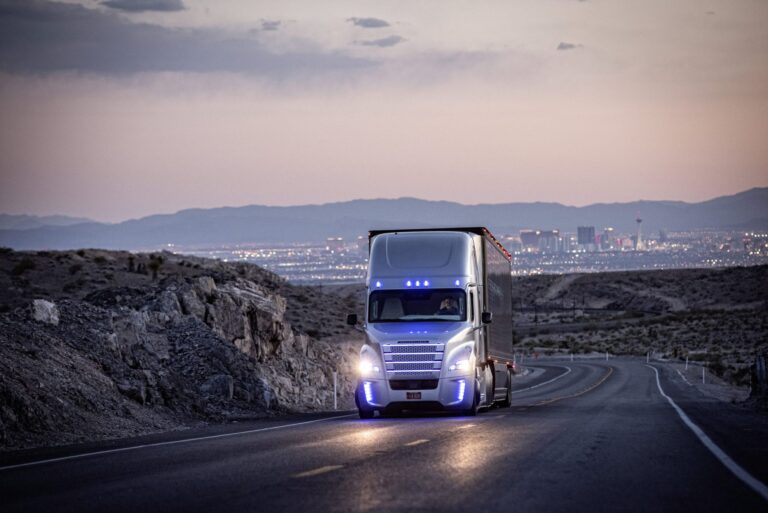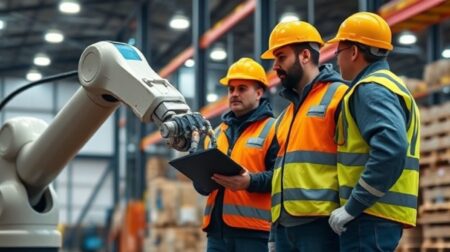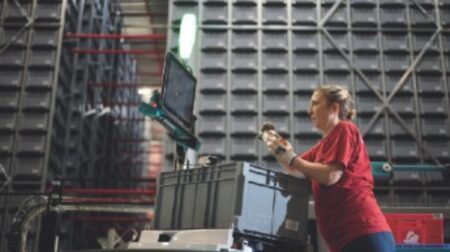With their ability to travel vast distances quicker and safer than current means, driverless trucks have the potential to transform how global supply chains operate. But just how close are we to seeing these vehicles operating on public roads? Alisdair Suttie attempts to find out…
Predicting when autonomous trucks will be a commercial reality on public roads is an inexact science. Ask 100 people within the technology’s sector and you’ll have as many different answers. Yet, all agree large commercial vehicle autonomy is not only inevitable but welcome and on its way sooner rather than later.
Defining that time period is harder to pin down. It also depends on what level of autonomy is being discussed. Jolyon Carroll, head of automated vehicle technologies at the Transport Research Laboratory in the UK, says: “The headline date would be very soon for features such as advanced cruise control and lane assist. However, driverless or autonomous trucks are still quite a chunk of time away. It could be five or 10 years ahead and I’d say it’s very much in the medium term.”
Carroll’s note of caution is echoed by others, including Umberto de Pretto, secretary general of the International Road Transport Union, who earlier this year warned that while some “76% of transport companies expect autonomous trucks to be on the roads within the next decade and a third reckon it will be within five years”, for technology to take hold, the proper foundations must be in place.
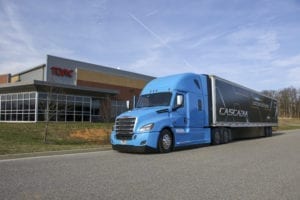
According to de Pretto, this means getting the basics right, such as full transitioning to digital documentation, improving traceability, security and efficiency. “We must work to join the dots between operators, service providers, manufacturers and governments to nurture a supportive environment for autonomy. We must also push for legislation and policies that encourage all operators to invest in the technology needed to make these innovations the norm.”
Even those with the most vested interest in seeing autonomous trucks being sold sooner rather than later are wary of putting a date on when the technology will initially be in commercial use, never mind commonplace. Maik Ziegler, director of Hyundai Motor’s commercial vehicle research and development strategy group, adds: “We’ve successfully demonstrated autonomous driving technology that can be used to transform the logistics industry. However, at this stage a human driver is still needed to control the vehicle manually in certain situations, but I believe we will achieve Level 4 autonomy soon.”
Better together
Many other truck manufacturers are developing their own autonomous vehicles, often in partnership with technology companies such as Daimler’s collaboration with Torc Robotics. There are also partnerships between autonomous tech companies and operators like the one between Tu Simple and UPS, where UPS has taken a financial stake in the US-based autonomous driving company.
These collaborations are helping to speed up the move towards autonomous trucks, as TuSimple’s head of government relations, Robert Brown, explains: “We’ve been testing on public roads in Tucson, Arizona for some time and the goal is to have two routes in place by 2021 as a proof of concept. This is needed to show the public, regulators and operators the technology is consistent and safe.
“It should be some time between 2022 and 2024 when a customer can order an autonomous package for their truck. By then, we believe the industry won’t be surprised to see autonomous trucks on the road and will be ready for the move.”

However, some within the industry believe that move might not be to full use on public roads but within the more easily controlled confines of a depot or port. “The difficulty for the technology on public roads is how it works with developing situations and having the perception to assess events before the driver can be removed from the process,” says TRL’s Carroll. “It’s very desirable to have an autonomous truck within a depot as it’s a defined environment.”
Line up
Another area where autonomy could make its mark early on is platooning. This method of convoying several trucks in a close formation has obvious benefits for reducing fuel use. Autonomy can also help smooth out vehicle inputs from the throttle and brakes, as well as reducing tyre scrub, which all have considerable cost implications and benefits for an operator. “Platooning is not necessarily a real step towards autonomy,” argues Carroll. “It’s more of an advanced cruise control with a relatively low level of autonomous technology required. It doesn’t allow pre-emptive interventions due to platooning being reactive.”
However, Fusion Processing is set to conduct an £8.1m (US$10.1m) platooning trial in the UK called HelmUK. It will use three DAF trucks and follows a period of test track evaluation and driver training. This last point shows that platooning at present is not fully autonomous as the lead truck’s speed, acceleration and braking are all governed by the human driver.
Much of this comes down to regulatory reasons and concerns about safety. Regulation is the bigger hurdle to overcome for autonomous trucks as it will require vehicles to pass a type approval standard. This means having an agreed set of test procedures in place and they have to be good enough to ensure any vehicle that passes is capable of reliable, safe on-road use in any situation. At present, such tests are not in place in many markets.
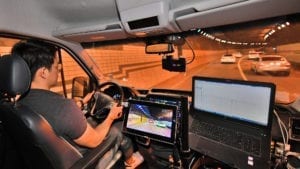
TuSimple’s Brown says: “In the USA, we have a 50-state agreement and 38 states already permit the testing of autonomous trucks. This is helping overcome the regulatory barriers and everyone within the industry is working towards harmonious vehicle validation.
“I think public perception is as big challenge as people want to know that large trucks can operate and stop as they need to on public roads. However, we also need to remember that large trucks don’t drive on as many routes as passenger cars, so we’re less reliant on the likes of 5G connectivity. We can’t wait for 5G in the truck industry when we have to work in some very remote areas.”
Loud and clear
Without the need to rely on 5G networks that so many autonomous passenger vehicles are looking to use for reliable vehicle-to-vehicle and vehicle-to-everything connectivity, the truck industry is moving ahead, and the benefits are clear to operators. Truck drivers are among the most at-risk groups of professional drivers and are 10 times more likely to be killed at work than other working drivers on public roads. By reducing their driving hours and stress, journeys are safer and the reduction in collisions is set to have a considerable impact on insurance costs for operators.
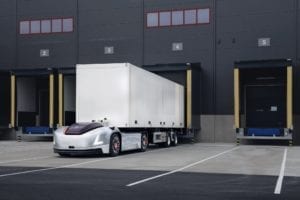
Other financial incentives for operators to use an autonomous truck include reduced wear on the vehicle and potentially being able to carry more goods as design changes. With increasing autonomy, there’s less need for sleeper cabs, which could allow for larger load spaces. This would also reduce overall vehicle weight, which further improves efficiency and reduces service and maintenance costs.
Even so, don’t expect to see too many autonomous trucks that look like Volvo’s Vera project, which it is developing in conjunction with DFDS for use in at an APM Terminals port facility in Gothenburg. Mikael Karlsson, Vice President of autonomous solutions at Volvo Trucks, says: “Autonomous transport with low noise levels and zero exhaust emissions have an important role to play in the future of logistics and will benefit both business and society. It’s an important start. Vera may have a speed limit, but we don’t.”

